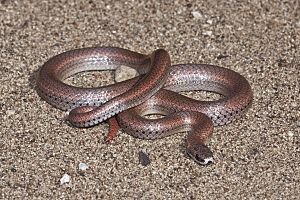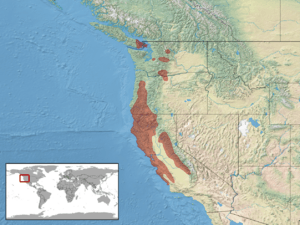Sharp-tailed snake facts for kids
The sharp-tailed snake (Contia tenuis) is a small snake. It belongs to the Colubridae family, which is a big group of snakes. You can only find this snake in the Western United States and British Columbia, Canada.
Quick facts for kids Sharp-tailed snake |
|
|---|---|
 |
|
| Conservation status | |
| Scientific classification | |
 |
|
| Synonyms | |
Contents
What's in a Name?
This snake has many other names! People also call it the brown snake, Oregon worm snake, or even the purple-tailed snake.
Where Do Sharp-Tailed Snakes Live?
You can find the sharp-tailed snake in several places. It lives in the states of California, Oregon, and Washington in the USA. It also lives in British Columbia, Canada. Some places in Canada where it's found include southern Vancouver Island near Victoria, British Columbia, and a new spot in Pemberton, British Columbia.
What Do Sharp-Tailed Snakes Look Like?
Adult sharp-tailed snakes are usually about 12–18 in (30–46 cm) long. They are easy to spot because of their special tail. The very tip of their tail has a sharp, pointy spine. Don't worry, this spine is not poisonous and won't hurt you! The snake uses its tail to hold onto small prey, like slugs, while it eats them.
The top of the snake's body can be grayish-brown, brown, or even brick red. Sometimes, you might even see ones that are bubble-gum pink or peachy-orange! The bottom side of the snake is very cool. It has bold black and white stripes that go across its belly.
How Do Sharp-Tailed Snakes Behave?
The sharp-tailed snake is a very shy and secret animal. You will most often find it hiding under rocks or logs. It almost never comes out into the open. These snakes can even live in cities if they can find good places to hide.
They like to dig into soft soil or small cracks in the ground. So, if you are digging in a garden or removing concrete, you might find one! If a sharp-tailed snake feels scared, it might curl up into a ball and stay very still. Because of its small size, some people might even mistake it for a worm!
What Do Sharp-Tailed Snakes Eat?
Sharp-tailed snakes have a very specific diet. They mostly eat slugs. They also enjoy eating slug eggs.
Reproduction and Life Cycle
In the summer, a female sharp-tailed snake will lay her eggs. She usually lays between 4 and 16 eggs. She hides them underground or inside a burrow to keep them safe. When the baby snakes hatch, they are very tiny, only about 3–4 in (7.6–10.2 cm) long!
Images for kids




